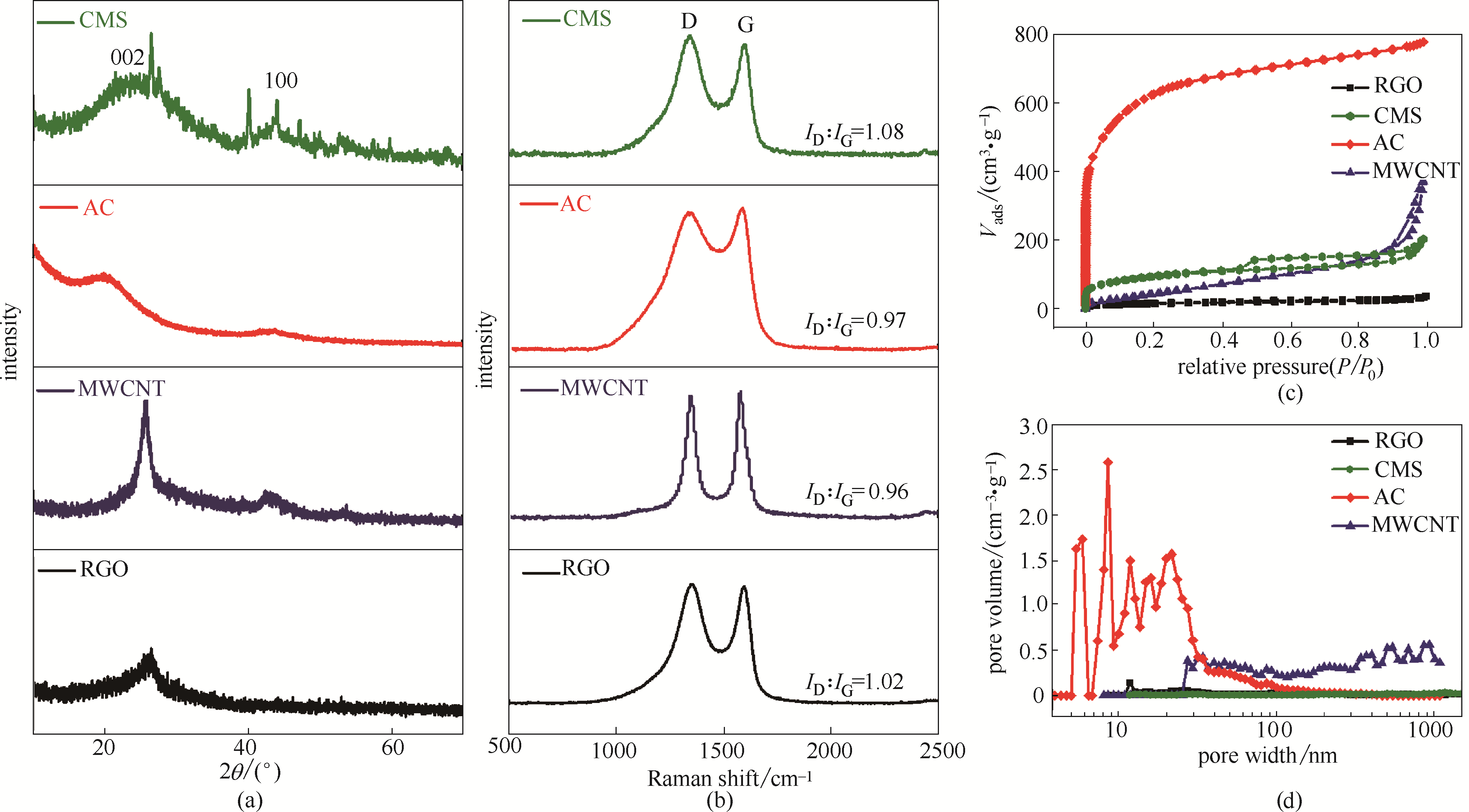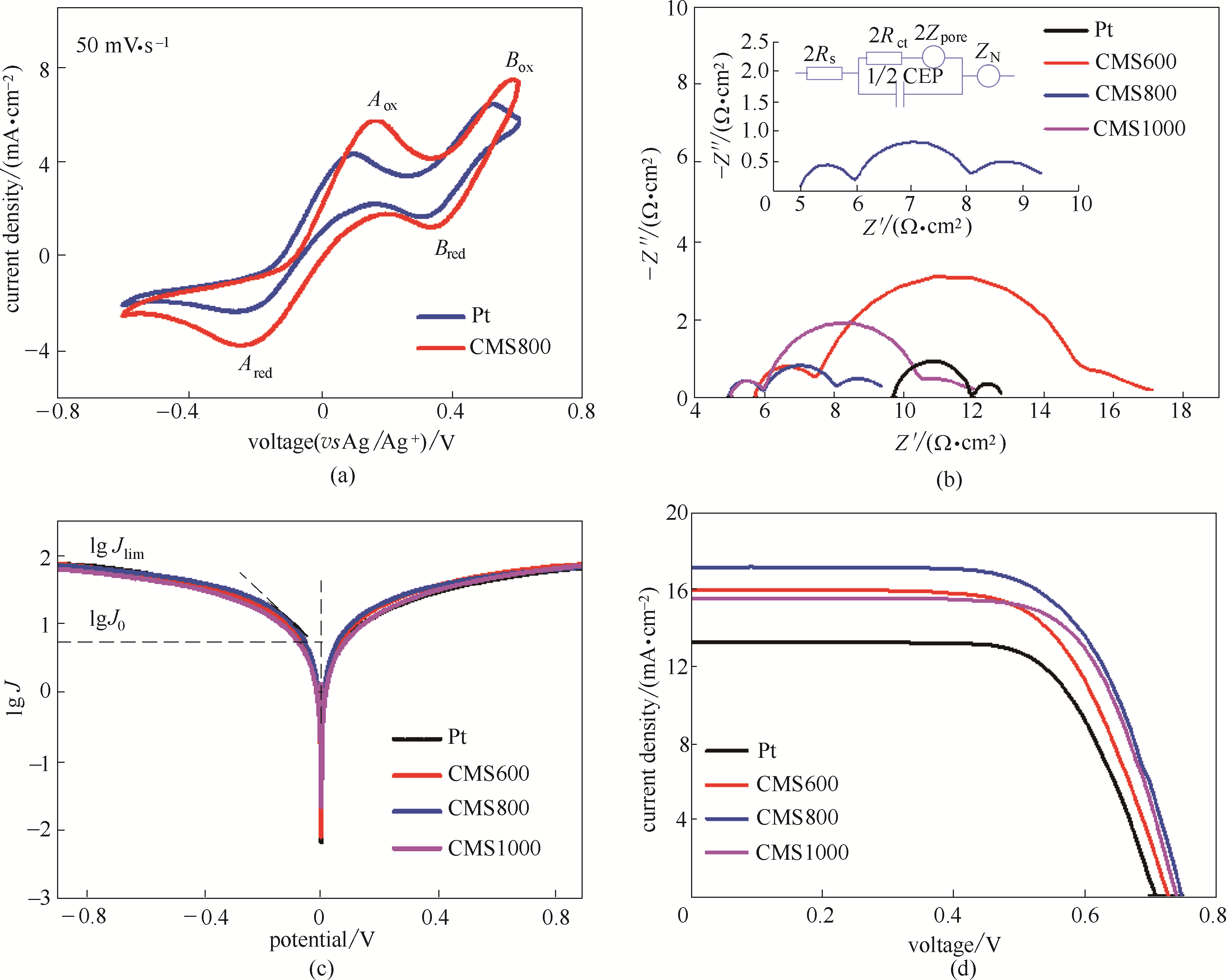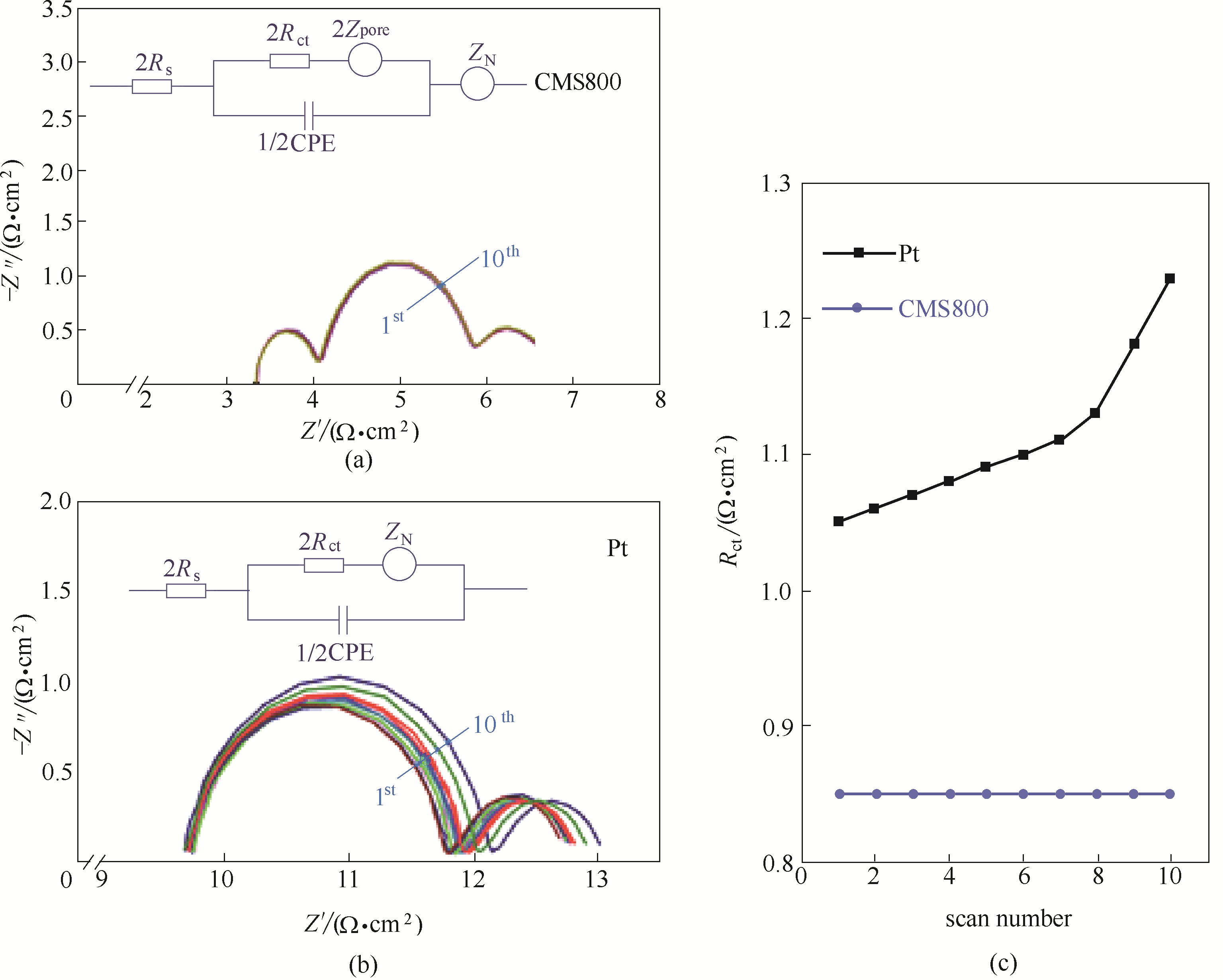CIESC Journal ›› 2020, Vol. 71 ›› Issue (6): 2696-2704.DOI: 10.11949/0438-1157.20191533
• Material science and engineering, nanotechnology • Previous Articles Next Articles
Chun YAO1( ),Longlong HUANG1,Jiangwei CHANG1,Yiwang DING1,Chang YU1(
),Longlong HUANG1,Jiangwei CHANG1,Yiwang DING1,Chang YU1( ),Jieshan QIU2(
),Jieshan QIU2( )
)
Received:2019-12-17
Revised:2020-02-26
Online:2020-06-05
Published:2020-06-05
Contact:
Chang YU,Jieshan QIU
姚春1( ),黄龙龙1,常江伟1,丁一旺1,于畅1(
),黄龙龙1,常江伟1,丁一旺1,于畅1( ),邱介山2(
),邱介山2( )
)
通讯作者:
于畅,邱介山
作者简介:姚春(1995—),女,硕士研究生,基金资助:CLC Number:
Chun YAO, Longlong HUANG, Jiangwei CHANG, Yiwang DING, Chang YU, Jieshan QIU. Optimization design of carbon molecular sieves and its I3- reduction performance[J]. CIESC Journal, 2020, 71(6): 2696-2704.
姚春, 黄龙龙, 常江伟, 丁一旺, 于畅, 邱介山. 碳分子筛的优化设计及其I3-还原性能研究[J]. 化工学报, 2020, 71(6): 2696-2704.
Add to citation manager EndNote|Ris|BibTeX

Fig.2 XRD patterns (a), Raman spectra (b), nitrogen adsorption and desorption isotherms (c) and the pore size distribution (d) of CMS, AC, MWCNT and RGO

Fig.3 CV curves of various CEs(a); Nyquist plots curves (inset is the magnified plots and equivalent circuits) (b); Tafel curves of the symmetrical dummy cells assembled by various CEs (c) and J-V curves of DSSCs based on various CEs (d)
| 对电极 | Rs /(Ω·cm2) | Rct/(Ω·cm2) |
|---|---|---|
| AC | 5.76 | 5.81 |
| MWCNT | 5.24 | 0.41 |
| RGO | 4.88 | 5.90 |
| CMS | 5.12 | 2.23 |
Table 1 Electrochemical parameters derived from EIS measurements for various CEs
| 对电极 | Rs /(Ω·cm2) | Rct/(Ω·cm2) |
|---|---|---|
| AC | 5.76 | 5.81 |
| MWCNT | 5.24 | 0.41 |
| RGO | 4.88 | 5.90 |
| CMS | 5.12 | 2.23 |
| 对电极 | Voc/V | Jsc/(mA·cm-2) | FF | PCE/% |
|---|---|---|---|---|
| AC | 0.77 | 14.79 | 0.61 | 6.88 |
| MWCNT | 0.71 | 13.78 | 0.66 | 6.41 |
| RGO | 0.78 | 14.92 | 0.61 | 7.13 |
| CMS | 0.74 | 16.59 | 0.61 | 7.46 |
Table 2 Photovoltaic parameters for various CEs
| 对电极 | Voc/V | Jsc/(mA·cm-2) | FF | PCE/% |
|---|---|---|---|---|
| AC | 0.77 | 14.79 | 0.61 | 6.88 |
| MWCNT | 0.71 | 13.78 | 0.66 | 6.41 |
| RGO | 0.78 | 14.92 | 0.61 | 7.13 |
| CMS | 0.74 | 16.59 | 0.61 | 7.46 |

Fig.5 CV curves for CMS800 and Pt CEs(a); Nyquist plots curves (inset is the magnified plots and equivalent circuits) (b) and Tafel curves (c) of the symmetrical dummy cells assembled by various CEs; J-V curves of DSSCs based on various CEs (d)
| 对电极 | Rs /(Ω·cm2) | Rct /(Ω·cm2) |
|---|---|---|
| CMS600 | 5.56 | 2.02 |
| CMS800 | 5.00 | 1.03 |
| CMS1000 | 5.01 | 1.31 |
| Pt | 9.78 | 1.08 |
Table 3 Electrochemical parameters derived from EIS measurements for various CEs
| 对电极 | Rs /(Ω·cm2) | Rct /(Ω·cm2) |
|---|---|---|
| CMS600 | 5.56 | 2.02 |
| CMS800 | 5.00 | 1.03 |
| CMS1000 | 5.01 | 1.31 |
| Pt | 9.78 | 1.08 |
| 对电极 | Voc/V | Jsc/(mA·cm-2) | FF | PCE/% |
|---|---|---|---|---|
| CMS600 | 0.73 | 16.01 | 0.65 | 7.65 |
| CMS800 | 0.75 | 17.03 | 0.67 | 8.56 |
| CMS1000 | 0.74 | 15.56 | 0.69 | 8.04 |
| Pt | 0.71 | 13.31 | 0.69 | 6.53 |
Table 4 Photovoltaic parameters for various CEs
| 对电极 | Voc/V | Jsc/(mA·cm-2) | FF | PCE/% |
|---|---|---|---|---|
| CMS600 | 0.73 | 16.01 | 0.65 | 7.65 |
| CMS800 | 0.75 | 17.03 | 0.67 | 8.56 |
| CMS1000 | 0.74 | 15.56 | 0.69 | 8.04 |
| Pt | 0.71 | 13.31 | 0.69 | 6.53 |

Fig.6 Electrochemical stability of CMS800 (a) and Pt (b) dummy cells, the EIS tests were repeated for 10 times (inset is the equivalent circuits); Rct changes of CMS800 and Pt CEs versus the EIS scan number (c)
| 26 | Yu C, Liu Z Q, Chen Y W, et al. CoS nanosheets-coupled graphene quantum dots architectures as a binder-free counter electrode for high-performance DSSCs [J]. Science China Materials, 2016, 59(2): 104-111. |
| 27 | Rungta M, Wenz G B, Zhang C, et al. Carbon molecular sieve structure development and membrane performance relationships [J]. Carbon, 2017, 115: 237-248. |
| 1 | Mahmoud M S, Akhtar M S, Mohamed I M A, et al. Demonstrated photons to electron activity of S-doped TiO2 nanofibers as photoanode in the DSSC [J]. Materials Letters, 2018, 225: 77-81. |
| 2 | Chen J, Li X, Wu W J, et al. A fast approach to optimize dye loading of photoanode via ultrasonic technique for highly efficient dye-sensitized solar cells [J]. Journal of Energy Chemistry, 2015, 24(6): 750-755. |
| 28 | Zhou Y W, Wang Y C, Ban Y J, et al. Carbon molecular sieving membranes for butane isomer separation [J]. AIChE Journal, 2019, 65(11): 16749. |
| 29 | Zhang S W, Lv W, Luo C, et al. Commercial carbon molecular sieves as a high performance anode for sodium-ion batteries [J]. Energy Storage Materials, 2016, 3: 18-23. |
| 3 | Mathew S, Yella A, Gao P, et al. Dye-sensitized solar cells with 13% efficiency achieved through the molecular engineering of porphyrin sensitizers [J]. Nature Chemistry, 2014, 6: 242-247. |
| 4 | Soman S, Pradhan S C, Yoosuf M, et al. Probing recombination mechanism and realization of marcus normal region behavior in DSSCs employing cobalt electrolytes and triphenylamine dyes [J]. The Journal of Physical Chemistry C, 2018, 122(25): 14113-14127. |
| 5 | Freitag M, Teuscher J, Saygili Y, et al. Dye-sensitized solar cells for efficient power generation under ambient lighting [J]. Nature Photonics, 2017, 11: 372-378. |
| 6 | Wu K Z, Chen L, Cui W Z, et al. The effect of transition metal ions (M2+=Mn2+, Ni2+, Co2+, Cu2+) on the chemical synthesis polyaniline as counter electrodes in dye-sensitized solar cells [J]. Chinese Journal of Chemical Engineering, 2017, 25(5): 671-675. |
| 30 | Meng X T, Yu C, Song X D, et al. Scrutinizing defects and defect density of selenium-doped graphene for high-efficiency triiodide reduction in dye-sensitized solar cells [J]. Angewandte Chemie International Edition, 2018, 57(17): 4682-4686. |
| 31 | Sarkar A, Chakraborty A K, Bera S. NiS/rGO nanohybrid: an excellent counter electrode for dye sensitized solar cell [J]. Solar Energy Materials and Solar Cells, 2018, 182: 314-320. |
| 7 | Yu C, Meng X T, Song X D, et al. Graphene-mediated highly-dispersed MoS2 nanosheets with enhanced triiodide reduction activity for dye-sensitized solar cells [J]. Carbon, 2016, 100: 474-483. |
| 8 | Wu J H, Lan Z, Lin J M, et al. Counter electrodes in dye-sensitized solar cells [J]. Chemical Society Reviews, 2017, 46(19): 5975-6023. |
| 9 | Fang H Q, Yu C, Ma T L, et al. Boron-doped graphene as a high-efficiency counter electrode for dye-sensitized solar cells [J]. Chemical Communications, 2014, 50(25): 3328-3330. |
| 10 | Meng X T, Yu C, Song X D, et al. Nitrogen-doped graphene nanoribbons with surface enriched active sites and enhanced performance for dye-sensitized solar cells [J]. Advanced Energy Materials, 2015, 5(11): 1500180. |
| 11 | Regan B O, Grätzel M. A low-cost, high-efficiency solar cell based on dye-sensitized colloidal TiO2 films [J]. Nature, 1991, 353(6346): 737-740. |
| 12 | Meng X T, Yu C, Lu B, et al. Dual integration system endowing two-dimensional titanium disulfide with enhanced triiodide reduction performance in dye-sensitized solar cells [J]. Nano Energy, 2016, 22: 59-69. |
| 13 | Yao Z Y, Zhang M, Wu H, et al. Donor/acceptor indenoperylene dye for highly efficient organic dye-sensitized solar cells [J]. Journal of the American Chemical Society, 2015, 137(11): 3799-3802. |
| 14 | Yu C, Fang H Q, Liu Z Q, et al. Chemically grafting graphene oxide to B, N co-doped graphene via ionic liquid and their superior performance for triiodide reduction [J]. Nano Energy, 2016, 25: 184-192. |
| 15 | Meng X T, Yu C, Son X D, et al. Rational design and fabrication of sulfur-doped porous graphene with enhanced performance as a counter electrode in dye-sensitized solar cells [J]. Journal of Materials Chemistry A, 2017, 5(5): 2280-2287. |
| 16 | 徐顺建. 9种树叶生物炭作为染料敏化太阳电池对电极的光电性能 [J]. 化工学报, 2016, 67(11): 4851-4857. |
| Xu S J. Photovoltaic properties of 9 natural leaves derived biochars as counter electrodes for dye-sensitized solar cells [J]. CIESC Journal, 2016, 67(11): 4851-4857. | |
| 17 | Xing Y D, Zheng X J, Wu Y H, et al. Nitrogen-doped carbon nanotubes with metal nanoparticles as counter electrode materials for dye-sensitized solar cells [J]. Chemical Communications, 2015, 51(38): 8146-8149. |
| 18 | Yu C, Liu Z Q, Meng X T, et al. Nitrogen and phosphorus dual-doped graphene as a metal-free high-efficiency electrocatalyst for triiodide reduction [J]. Nanoscale, 2016, 8(40): 17458-17464. |
| 19 | Meng X T, Yu C, Zhang X P, et al. Active sites-enriched carbon matrix enables efficient triiodide reduction in dye-sensitized solar cells: an understanding of the active centers [J]. Nano Energy, 2018, 54: 138-147. |
| 20 | Chang P J, Cheng K Y, Chou S W, et al. Tri-iodide reduction activity of shape- and composition-controlled PtFe nanostructures as counter electrodes in dye-sensitized solar cells [J]. Chemistry of Materials, 2016, 28(7): 2110-2119. |
| 21 | Liu T S, Zhao Y Y, Duan J L, et al. Transparent ternary alloy counter electrodes for high-efficiency bifacial dye-sensitized solar cells [J]. Solar Energy, 2018, 170: 762-768. |
| 22 | Zhang J B, Hao Y, Yang L, et al. Electrochemically polymerized poly (3, 4-phenylenedioxythiophene) as efficient and transparent counter electrode for dye sensitized solar cells [J]. Electrochimica Acta, 2019, 300: 482-488. |
| 23 | Nemala S S, Kartikay P, Agrawal R K, et al. Few layers graphene based conductive composite inks for Pt free stainless steel counter electrodes for DSSC [J]. Solar Energy, 2018, 169: 67-74. |
| 24 | Ren H, Shao H, Zhang L J, et al. A new graphdiyne nanosheet/Pt nanoparticle-based counter electrode material with enhanced catalytic activity for dye-sensitized solar cells [J]. Advanced Energy Materials, 2015, 5(12): 1500296. |
| 25 | Wang Z H, Lu B, Meng X T, et al. Graphene oxide induced fabrication of pillared and double-faced polyaniline arrays with enhanced triiodide reduction capability [J]. Electrochimica Acta, 2017, 252: 84-90. |
| [1] | Wei WANG, Weixing QIAN, Hongfang MA, Weiyong YING, Haitao ZHANG. A theoretical study on adsorption-diffusion of dimethyl ether carbonylation on pyridine-modified H-MOR [J]. CIESC Journal, 2021, 72(9): 4786-4795. |
| [2] | YU Chengyuan, WU Jinkui, ZHOU Li, JI Xu, DAI Yiyang, DANG Yagu. Prediction of energy conversion efficiency of organic solar cells based on deep learning [J]. CIESC Journal, 2021, 72(3): 1487-1495. |
| [3] | YAO Shuhua, CHEN Shuang, ZOU Peichen, SHI Lei, SHI Zhongliang. Adsorption performance and photocatalytic activity of H3PW12O40 doped titanium dioxide photocatalyst [J]. CIESC Journal, 2015, 66(9): 3456-3461. |
| [4] | LI Guohua, YANG Wei, TONG Mingxing, ZHENG Xiang. Preparation of WC/MMT nanocomposite and its electrocatalytic activityfor p-nitrophenol [J]. CIESC Journal, 2015, 66(9): 3776-3781. |
| [5] | FU Qiaoming, ZHAO Chungui, YANG Suping. Photoelectric conversion performance of natural photosynthetic pigments from three typical members of purple bacteria for dye-sensitized solar cells [J]. CIESC Journal, 2014, 65(8): 3202-3211. |
| [6] | CUI Lijuan,XU Gang,MENG Xiao,WU Jianping,YANG Lirong. Multi-electrolytes activation of Lipase for 4-methylhept-4-en-1-yn-3-ol resolution in organic media [J]. Chemical Industry and Engineering Progree, 2014, 33(08): 2150-2159. |
| [7] | JIANG Hongguo, YANG Zujin, ZHOU Xiantai, FANG Yanxiong, JI Hongbing. Immobilization of β-cyclodextrin as insoluble β-cyclodextrin polymer and its catalytic performance [J]. Chin.J.Chem.Eng., 2012, 20(4): 784-792. |
| [8] | CHENG Yuan, XIE Wei-Miao, YAO Guo-Xin, HU Su-Juan, LI Guo-Hua. Electrocatalytic activity of tungsten carbide and natural zeolite composite in aqueous solution [J]. , 2012, 20(2): 254-261. |
| [9] | WEI Zhaoni,CHEN Shufang,LIN Cheng. Ultrasonic synthesis and characterization of Zr-pillared montmorillonite for MTO catalytic reaction [J]. Chemical Industry and Engineering Progree, 2012, 31(07): 1501-1506. |
| [10] | SUN Xuhui1,2,BAO Tana1,ZHANG Lingyun1,ZHANG Guohua1,WANG Weiguang1. Research progress of dye-sensitized solar cells [J]. Chemical Industry and Engineering Progree, 2012, 31(01 ): 47-52. |
| [11] | LIAO Jianjun,LI Shipu,CAO Xiankun,CAO Yang,LIN Shiwei. Review on photocatalytic activity of highly ordered TiO2 nanotube arrays [J]. , 2011, 30(9): 2003-. |
| [12] | XU Qiong1,ZOU Lixia1,2,XIONG Xiaoqing1. Structure and Property of nano crystalline WO3·NiO·0.33H2O photo-catalyst [J]. , 2010, 29(2): 260-. |
| [13] | SHI Jianwen,CHEN Shaohua,WANG Shumei,LUO Hongyuan. Synergy of codoped nanometer titania photocatalyst [J]. , 2009, 28(2): 251-. |
| [14] | TONG Shaoping, ZHANG Tieming, MA Chun'an. Oxygen Evolution Behavior of PTFE-F-PbO2 Electrode in H2SO4 Solution [J]. , 2008, 16(6): 885-889. |
| [15] | NIE Lihong,XU Shaoping,SU Yanmin,LIU Shuqin. Progress of recovery of low concentration coal bed methane [J]. , 2008, 27(10): 1505-. |
| Viewed | ||||||
|
Full text |
|
|||||
|
Abstract |
|
|||||